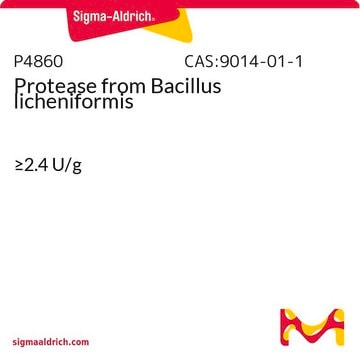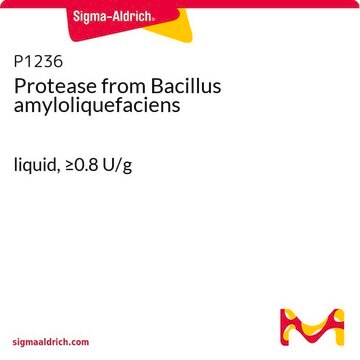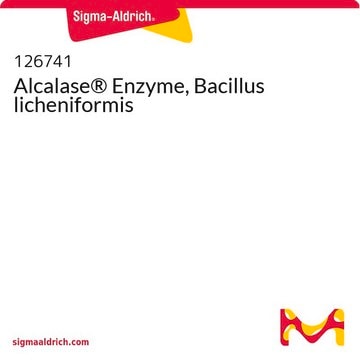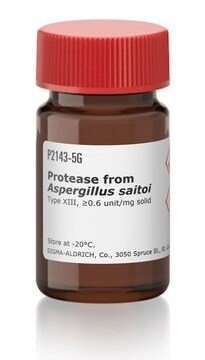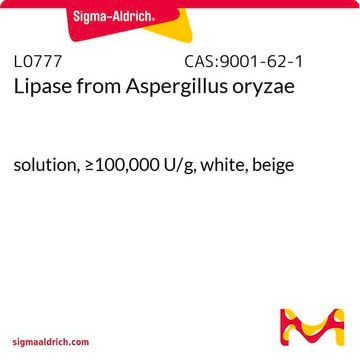P3111
Protease from Bacillus sp.
liquid, ≥16 U/g
Synonym(s):
Savinase® 16.0L
Sign Into View Organizational & Contract Pricing
All Photos(1)
About This Item
Recommended Products
biological source
Bacillus sp.
form
liquid
specific activity
≥16 U/g
mol wt
20-30 kDa
storage temp.
2-8°C
Looking for similar products? Visit Product Comparison Guide
Related Categories
Application
Protease is an enzyme used to break down proteins by hydrolyzing peptide bonds. Product P3111 is secreted from Bacillus sp.. It is a serine-type protease characterized by excellent performance at elevated temperature and pH. Product P3111 is extremely stable under harsh storage conditions, such as in the presence of sodium hypochlorite. Protease is used to degrade proteins, to study protease inhibitors and to study thermal inactivation kinetics.
Biochem/physiol Actions
Protease catabolizes proteins by hydrolysis of peptide bonds. Proteases are inactivated by serine active-site inhibitors, such as phenylmethylsulfonyl fluoride (PMSF) and diisopropylfluorophosphate. Proteases, secreted from Bacillus sp., typically have molecular weights ranging from 20,000 to 30,000. They are typically stabilized by Ca2+ and have high isoelectric points. It is highly soluble in detergents at a wide range of pH and temperatures.
Legal Information
A product of Novozyme Corp.
Savinase is a registered trademark of Novozymes Corp.
Signal Word
Danger
Hazard Statements
Precautionary Statements
Hazard Classifications
Acute Tox. 4 Oral - Aquatic Acute 1 - Aquatic Chronic 2 - Eye Dam. 1 - Resp. Sens. 1 - Skin Irrit. 2 - STOT SE 3
Target Organs
Respiratory system
Storage Class Code
10 - Combustible liquids
WGK
WGK 2
Personal Protective Equipment
dust mask type N95 (US), Eyeshields, Gloves
Certificates of Analysis (COA)
Search for Certificates of Analysis (COA) by entering the products Lot/Batch Number. Lot and Batch Numbers can be found on a product’s label following the words ‘Lot’ or ‘Batch’.
Already Own This Product?
Find documentation for the products that you have recently purchased in the Document Library.
Customers Also Viewed
Alessio Gomiero et al.
Environmental science and pollution research international, 26(24), 24407-24416 (2019-06-24)
In recent years, the occurrence of microplastics in the aquatic environment has gathered increasing scientific interest. Several studies have shown that the ingestion of microplastics may negatively influence the physiology of marine organisms having different feeding strategies, particularly in those
Yoshifumi Shimada et al.
Human pathology, 66, 1-9 (2017-02-27)
HER2-targeted therapy is considered effective for KRAS codon 12/13 wild-type, HER2-positive metastatic colorectal cancer (CRC). In general, HER2 status is determined by the use of immunohistochemistry (IHC) and fluorescence in situ hybridization (FISH). Comprehensive genomic sequencing (CGS) enables the detection
Cheng Wang et al.
mSystems, 5(1) (2020-02-13)
Substantial annual economic loss in livestock production is caused by antinutritional factors in soybean meal and corn mixed substrates, which can be degraded by microbial fermentation. Although considerable efforts have been made to explain the effects of fermentation on soybean
Weifa Su et al.
Frontiers in microbiology, 12, 688839-688839 (2021-09-07)
Corn germ meal (CGM) and corn gluten feed (CGF) are the two main corn byproducts (CBs) obtained from corn starch extraction. Due to their high fiber content, low protein content, and severe imbalance of amino acid, CBs are unable to
Juliana A S Leite et al.
Frontiers in nutrition, 8, 626475-626475 (2021-03-30)
Proteases present in milk are heat-sensitive, and their activities increase or decrease depending on the intensity of the thermal treatment applied. The thermal effects on the protease activity are well-known for bovine milk but poorly understood for ovine and caprine
Our team of scientists has experience in all areas of research including Life Science, Material Science, Chemical Synthesis, Chromatography, Analytical and many others.
Contact Technical Service
